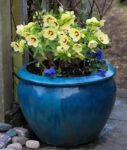
Hellebores: Winter Jewels for Mountain Gardens
|
Text to speech audio articles made possible by the Quest Grant at Yavapai College. Tuition free industry recognized certificates for your career.
|
This week, Ken Lain, The Mountain Gardener of Prescott, takes a deep dive into growing hellebores, the winter jewels of your mountain garden. Learn where to place this plant, how much they spread, if you should cut them back, and more.
The mountain garden can be a challenging but rewarding endeavor. Our unique climate, with its cold winters and intense sunlight, calls for unique plants that survive and thrive. Enter the enchanting Hellebore, a winter-blooming marvel that brings color and life to the garden when most other plants are dormant.
Why Hellebores are Perfect for Prescott Gardens
Hellebores, also known as Lenten roses, are evergreen perennials that offer a multitude of benefits for mountain perennial beds and container gardens:
- Winter Blooms: Hellebores flower from late winter to early spring, providing much-needed color when the garden is still asleep. Imagine these beauties peeking through the snow!
- Shade Tolerance: They thrive in the dappled shade under deciduous trees, a common feature in many Prescott gardens.
- Drought Tolerance: Hellebores are drought-tolerant once established, making them water-wise choices for our arid climate.
- Deer Resistance: A significant plus for mountain gardeners, hellebores are unpalatable to deer and rabbits.
Long-lived: These tough plants grace your garden for decades with minimal care.
Choosing the Right Hellebore
Many different types of hellebores are available, each with its unique charm. Here are the popular choices with local gardeners:
- Helleborus orientalis (Lenten Rose) are the most common hellebores, with a wide range of colors including white, pink, purple, and even near-black. Many have intricate spotting or veining on the petals.
- Helleborus niger (Christmas Rose): True to its name, this variety often blooms around Christmas with pure white flowers.
- Helleborus foetidus (Stinking Hellebore): Don’t let the name fool you! This Hellebore has beautiful pale green flowers with purple edges and attractive foliage. The “stinking” refers to the scent of the leaves when crushed, which is not particularly noticeable.
Planting and Care
Hellebores prefer well-drained soil amended with Watters Premium Mulch. They thrive in partial shade, especially in areas receiving morning sun and afternoon shade. Here’s how to get them established:
- Planting Time: Late winter and early spring are the ideal time to plant hellebores in Prescott, allowing them to establish roots before the heat of summer.
- Soil Preparation: Amend the soil with Watters Premium Mulch to improve drainage and fertility.
- Planting Depth: Plant the crown of the Hellebore at the same level as the soil surface.
- Spacing: Space plants about 18-24″ inches apart to allow for growth.
- Irrigation: Water regularly after planting until established. Once established, they are drought-tolerant but appreciate supplemental watering during dry spells.
Tips for Success
- Fertilize: Feed with Watters 7-4-4 All Purpose Plant Food in early spring to encourage healthy growth and blooms.
- Mulch: Apply a layer of Premium Mulch around the plants to conserve moisture and suppress weeds.
- Deadhead: Remove spent flowers to promote more blooms and prevent self-seeding.
- Divide: Every few years, you can divide mature clumps in the fall and create new plants.
Enjoy the Show!
With their captivating beauty and resilience, hellebores will become a cherished addition to your mountain garden. Plant them this fall, and enjoy their enchanting blooms for many winters!
Until the next issue, I’ll be helping local gardeners plant pretty winter perennials here at Watters Garden Center.
Ken Lain can be found throughout the week at Watters Garden Center, 1815 Iron Springs Rd in Prescott, or contacted through his websites at WattersGardenCenter.com or Top10Flowers.com.
This article was written by Ken Lain. He can be found throughout the week at Watters Garden Center, 1815 W. Iron Springs Rd in Prescott, or contacted through his website at WattersGardenCenter.com or Top10Plants.com.
Get more gardening tips from Watters Garden Center in the Mountain Gardener Column on Signals A Z.com.
Garden Wisdom Awaits: Subscribe for Expert Tips!
Garden Wisdom Awaits: Subscribe for Expert Tips!









